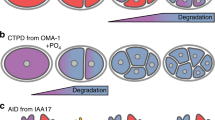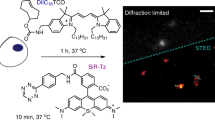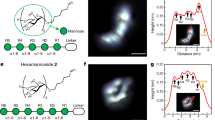Abstract
Modification patterns of heparan sulfate coordinate protein function in metazoans, yet in vivo imaging of such non–genetically encoded structures has been impossible. Here we report a transgenic method in Caenorhabditis elegans that allows direct live imaging of specific heparan sulfate modification patterns. This experimental approach reveals a dynamic and cell-specific heparan sulfate landscape and could in principle be adapted to visualize and analyze any extracellular molecule in vivo.
This is a preview of subscription content, access via your institution
Access options
Subscribe to this journal
Receive 12 print issues and online access
$259.00 per year
only $21.58 per issue
Buy this article
- Purchase on Springer Link
- Instant access to full article PDF
Prices may be subject to local taxes which are calculated during checkout


Similar content being viewed by others
References
Wang, S. & Hazelrigg, T. Nature 369, 400–403 (1994).
Laughlin, S.T., Baskin, J.M., Amacher, S.L. & Bertozzi, C.R. Science 320, 664–667 (2008).
Laughlin, S.T. & Bertozzi, C.R. ACS Chem. Biol. 4, 1068–1072 (2009).
Bishop, J.R., Schuksz, M. & Esko, J.D. Nature 446, 1030–1037 (2007).
Bülow, H.E. & Hobert, O. Annu. Rev. Cell Dev. Biol. 22, 375–407 (2006).
Holt, C.E. & Dickson, B.J. Neuron 46, 169–172 (2005).
van Kuppevelt, T.H., Dennissen, M.A., van Venrooij, W.J., Hoet, R.M. & Veerkamp, J.H. J. Biol. Chem. 273, 12960–12966 (1998).
Ten Dam, G.B. et al. J. Biol. Chem. 281, 4654–4662 (2006).
Smits, N.C. et al. Methods Enzymol. 416, 61–87 (2006).
Townley, R.A. & Bülow, H.E. J. Biol. Chem. 286, 16824–16831 (2011).
Lieleg, O., Baumgärtel, R.M. & Bausch, A.R. Biophys. J. 97, 1569–1577 (2009).
Hall, D.H. & Altun, Z.F. Muscle System. in C. elegans Atlas 145–188 (Cold Spring Harbor Laboratory Press, Cold Spring Harbor, New York, 2008).
Jenniskens, G.J. et al. FASEB J. 17, 878–880 (2003).
Dennissen, M.A. et al. J. Biol. Chem. 277, 10982–10986 (2002).
Kurup, S. et al. J. Biol. Chem. 282, 21032–21042 (2007).
van de Westerlo, E.M. et al. Blood 99, 2427–2433 (2002).
Brenner, S. Genetics 77, 71–94 (1974).
Bénard, C., Tjoe, N., Boulin, T., Recio, J. & Hobert, O. Genetics 183, 917–927 (2009).
van Kuppevelt, T.H., Dennissen, M.A., van Venrooij, W.J., Hoet, R.M. & Veerkamp, J.H. J. Biol. Chem. 273, 12960–12966 (1998).
Fares, H. & Greenwald, I. Genetics 159, 133–145 (2001).
Grant, B. & Greenwald, I. Development 124, 637–644 (1997).
Loria, P.M., Hodgkin, J. & Hobert, O. J. Neurosci. 24, 2191–2201 (2004).
Hermann, G.J. et al. Mol. Biol. Cell 16, 3273–3288 (2005).
Hobert, O. Biotechniques 32, 728–730 (2002).
Acknowledgements
We thank J. Attonito, N. Gomez and P. Weinberg for technical assistance, H. Fares (University of Arizona, Tucson) for providing the pJF33 plasmid, E. Snapp (Albert Einstein College of Medicine) for the superfolder GFP plasmid, S. Mitani (Tokyo Women's Medical University School of Medicine) for providing the tm734, tm3006 and tm3208 alleles of heparan 3O-sulfotransferases, and L. Attreed, S. Emmons, O. Hobert and members of the Bülow laboratory for comments on the manuscript. This work was supported in part by grants from the US National Institutes of Health (5R01HD055380 and RC1GM090825 to H.E.B.; T32 GM007491 to M.A.). H.E.B. is funded as an Alfred P. Sloan fellow.
Author information
Authors and Affiliations
Contributions
M.A. conducted all experiments. M.D. constructed several transgenic strains and important constructs. T.H.v.K. contributed vsv-tagged scFv antibody preparations. M.A. and H.E.B. analyzed data and wrote the manuscript with editorial input from M.D. and T.H.v.K.
Corresponding author
Ethics declarations
Competing interests
The authors declare no competing financial interests.
Supplementary information
Supplementary Text and Figures
Supplementary Figures 1–12 (PDF 5473 kb)
Rights and permissions
About this article
Cite this article
Attreed, M., Desbois, M., van Kuppevelt, T. et al. Direct visualization of specifically modified extracellular glycans in living animals. Nat Methods 9, 477–479 (2012). https://doi.org/10.1038/nmeth.1945
Received:
Accepted:
Published:
Issue Date:
DOI: https://doi.org/10.1038/nmeth.1945
This article is cited by
-
Live imaging of sugars
Nature Reviews Molecular Cell Biology (2012)
-
Hitting the sweet spot
Nature Methods (2012)



